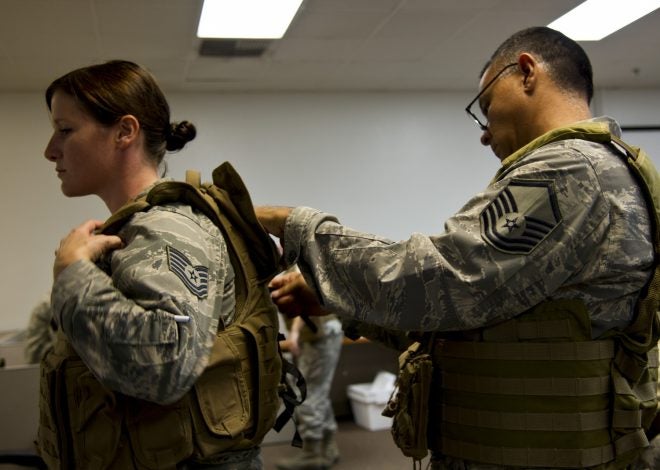The US Military is looking into lighter weight armor for the infantry. Both the Army and the Marine Corps are looking into reducing the weight of the personal protective equipment (PPE, read “helmet and body armor”) carried by the infantrymen of both services. Although armor protection has increased greatly since the beginning of the 2000s, it has been recognized that this may negatively affect the infantry via reductions in mobility and agility, as well as increasing the rate of injuries. Defense-Aerospace.com, citing the GAO, reports:
Army and Marine Corps officials stated that the PPE provides significant additional protection when compared with equipment used prior to operations in Iraq in the 2000s. However, they also noted that providing this level of protection adds significant bulk and weight to the total load on Soldiers and Marines, which could impede mobility and hinder combat effectiveness.
According to service-provided data, the typical total load in 2016 for Army and Marine Corps ground combat personnel averaged about 119 and 117 pounds, respectively, of which the primary PPE represented about 27 pounds based on equipment sizes (see figure). Officials stated that these totals have increased over time based on the incorporation of new PPE and other equipment.
Recognizing that the weight of PPE and other equipment could have negative effects on personnel performance, the Army and the Marine Corps have coordinated and developed goals for PPE-related weight reductions and are pursuing some efforts to reduce overall load burdens on personnel. The two services coordinate through formal working groups and informal methods to develop and improve PPE.
Army and Marine Corps officials stated that while they prioritize protection and operational capabilities when developing PPE, they have overarching goals of reducing weight, in addition to improving the form, fit, and function of equipment. These goals have led to reductions in the weight of some PPE. The Army is also developing a goal and plan to reduce the weight of hard armor plates by 20 percent by identifying and eliminating excess ballistic protection.
In addition, the Army and Marine Corps are pursuing other efforts to reduce the weight of PPE, such as by giving commanders the option to employ varying levels of PPE at their discretion and studying the effects of integrating PPE with overall combat loads. Finally, the Army and Marine Corps are exploring research initiatives that may reduce the total load on ground combat personnel, such as improvements to logistics and aerial delivery capabilities, load transferring systems, and other enhancements to equipment.
Read the whole article at Defense-Aerospace.com.
It is no secret that the modern infantryman is overburdened. The typical US Army infantryman today carries up to 80% of his body weight in equipment during a foot march. Further, a greater proportion of that equipment is today carried as part of the soldier’s combat gear (e.g., armor), meaning the soldier is carrying more of his maximum load more of the time. More or less all of this equipment is “mission critical”, but the weight has to come out somehow, which means each piece of kit – everything from armor to webbing to water bottles – must be subject to a weight assessment and reduction program. However, on the flip slide, reducing weight too much could compromise the durability, reliability, or effectiveness of each system. Thin out the armor plates, and more rounds might penetrate. Lighten the web gear, and it might break more easily. Reduce the weight of ammunition too much, and it might not be effective enough. All this together makes for a very tough problem that will require both careful study and sound engineering to solve.
Fortunately for the soldier, materials technology is improving apace, which means there might be technological solutions in the near future that could mean none of the critical characteristics of armor systems would have to be compromised to achieve a weight reduction.
 Your Privacy Choices
Your Privacy Choices
